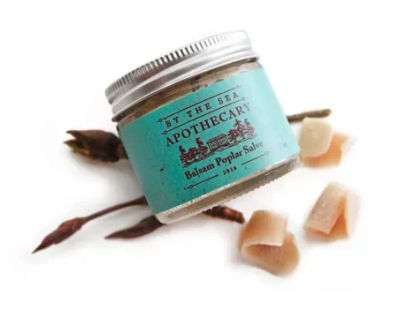Balm of Gilead was mentioned in the Bible, but we don’t know what was in it. It is supposed to relieve pain, but we don’t know if it is effective; there are no controlled studies.

I have been watching the National Geographic series Life Below Zero which profiles people who live off the grid in Alaska, often alone, meeting challenges with ingenuity and supplying their own needs by hunting, fishing, gathering, and cutting down trees for firewood. One of the people it features is Sue Aikens, a grandmother who lives alone at Kavik River Camp on the North Slope. One episode showed her preparing a salve from natural ingredients to treat her pain; she called it Balm of Gilead. She’s not an authority; she doesn’t have a medical or scientific background and relies on hearsay, but I wondered if there was any scientific evidence that Balm of Gilead was effective for relieving pain. I soon learned that we don’t really know what plant it was derived from.
Balm of Gilead was a rare perfume used medicinally, that was mentioned in the Hebrew Bible, and named for the region of Gilead, where it was produced. The expression stems from William Tyndale’s language in the King James Bible of 1611, and has come to signify a universal cure in figurative speech. The tree or shrub producing the balm is commonly identified as Commiphora gileadensis. However, some botanical scholars have concluded that the actual source was a terebinth tree in the genus Pistacia.
The Wikipedia article describes the linguistic confusion of various translations and lists various species of plant proposed as ingredients of the balm. Most of them are indigenous to the Middle East and do not grow in Alaska. Aikens may have used resin from the balsam poplar, but there is no evidence that that was in the Balm of Gilead mentioned in the Bible.
BytheSeaApothecary sells a healing salve containing “Wildcrafted Balsam polpar [sic] buds”. They describe it as “An aromatically rich all-purpose healing salve. Used for skin conditions including; eczema, psoriasis, diaper rash and chapped or itchy skin. Also provides relief to sore muscles, aching joints and sunburns and is gentle enough to use on children… works effortlessly to heal a multitude of skin conditions. Favoured by bees to prevent microbes and decay in their hives…”
They don’t provide any evidence for these claims.
Balm of Gilead is also the name of a project on end-of-life care for safety-net populations. They do not use the salve with that name.
The Balm of Gilead is also the title of a book about an ethnobotanist’s experience in the Amazon. I haven’t read the book, but I would be surprised if he claimed to have found actual Balm of Gilead in the Amazon. I presume the title was metaphorical.
It’s also the title of a novel and the name of an anointing oil sold by the Judaica webstore. They say:
This aromatic blend of essential oils is scented with the heady, sweet fragrance of Rose of Sharon, and enriched with the gold-colored sap extracted from the bark of balsam trees. Native to the Gilead region (an eastern territory of ancient Israel, now in Jordan), balsam trees and their resin are known for their antiseptic and analgesic properties. Perked up with invigorating mint, this anointing oil smells good and feels wonderful on the skin.
I checked PubMed and didn’t find much. One study found that beta-caryophyllene, a compound they say they isolated from the Biblical Balm of Gilead (which they identified as Commiphora gileadensis), is a selective apoptosis inducer for tumor cell lines. There were articles about the history and identification of plants that might have been in the Biblical balm, and a few non-helpful studies of poplar buds, but no controlled clinical studies of pain relief in humans.
Did the salve Sue Aikens prepared work to relieve her pain? The documentary didn’t say. If she thought it helped, we would have no way of knowing if it was just a placebo response.
Using a medicine mentioned in the Bible may impress some people, but we have no way of even knowing what was in the original Balm of Gilead or if it was effective. And we have no way of knowing whether the modern product Balm of Gilead or Sue’s homemade salve is effective. Would it be worth doing controlled studies? We might learn something, but I’m not convinced it would be worth taking the time and money away from other research that is more likely to be productive. Was it worth all the time and effort Sue Aikens put in to gather the ingredients and prepare the salve? If she had a placebo response, she might think so. It might have been just as effective to take her own advice: her motto is “If it hurts, don’t think about it.” That approach may not be possible for everyone, but it was for her. According to a report on the internet, when she was severely mauled by a grizzly bear and her hips were dislocated, she dragged herself to shelter and even managed to go out and kill the bear before she was found 10 days after the attack.
This article was originally published in the Science-Based Medicine Blog.
